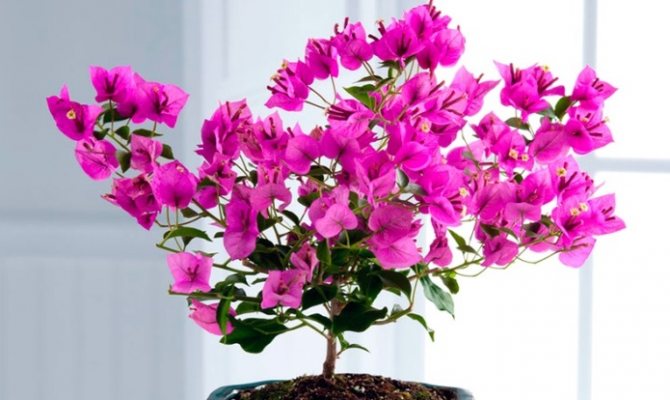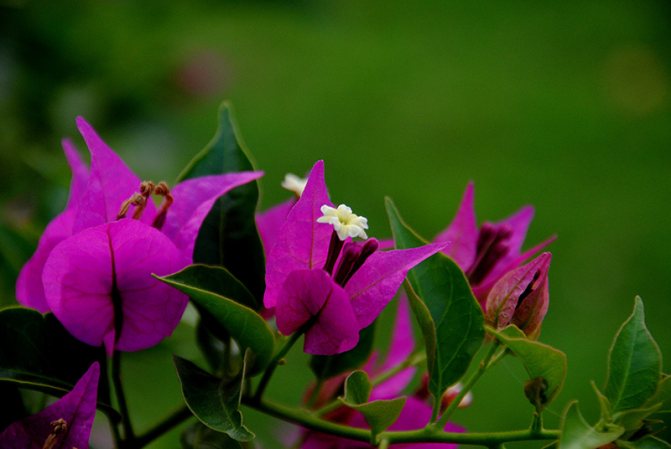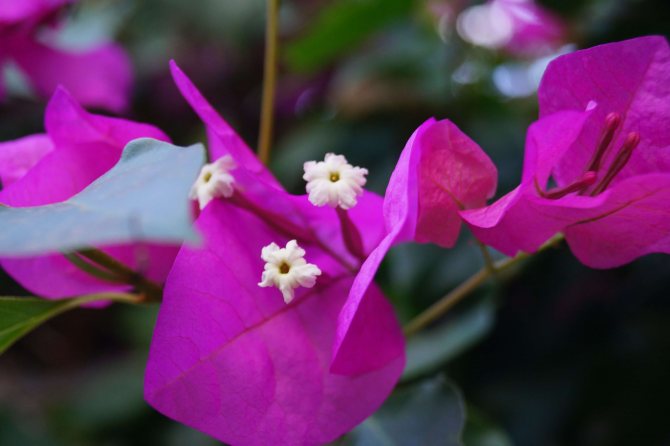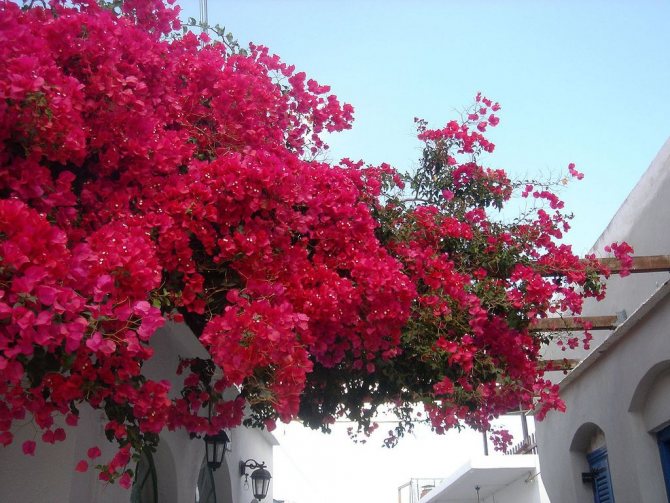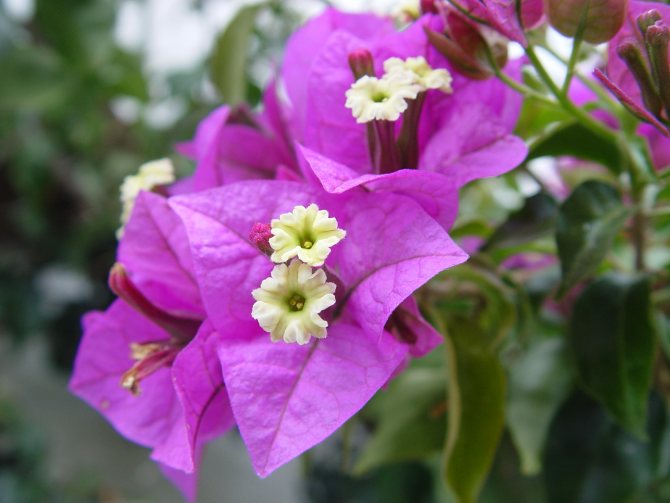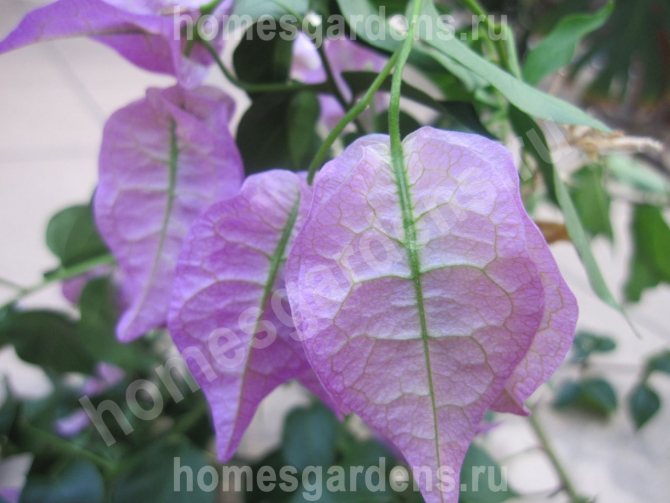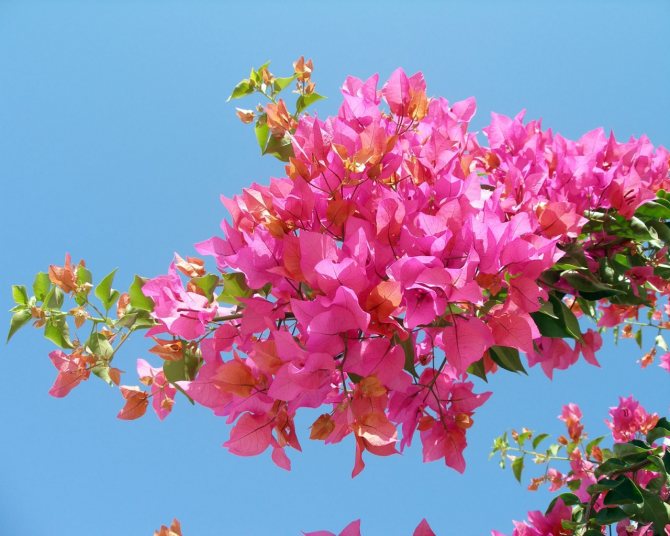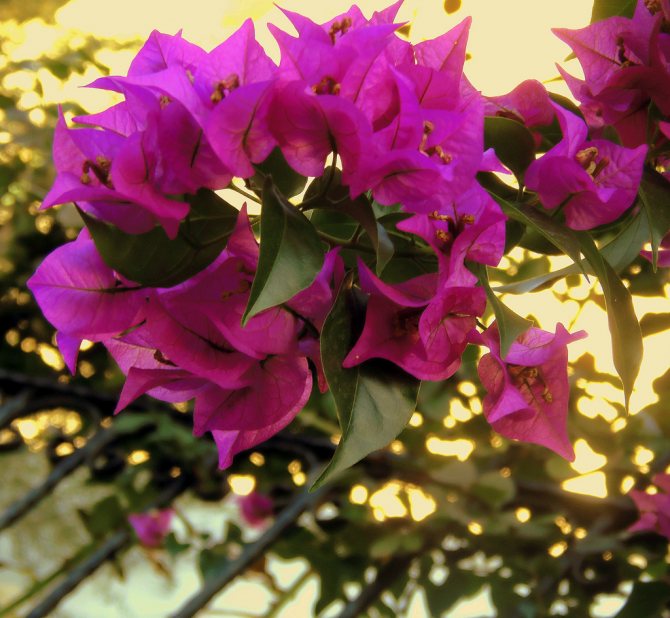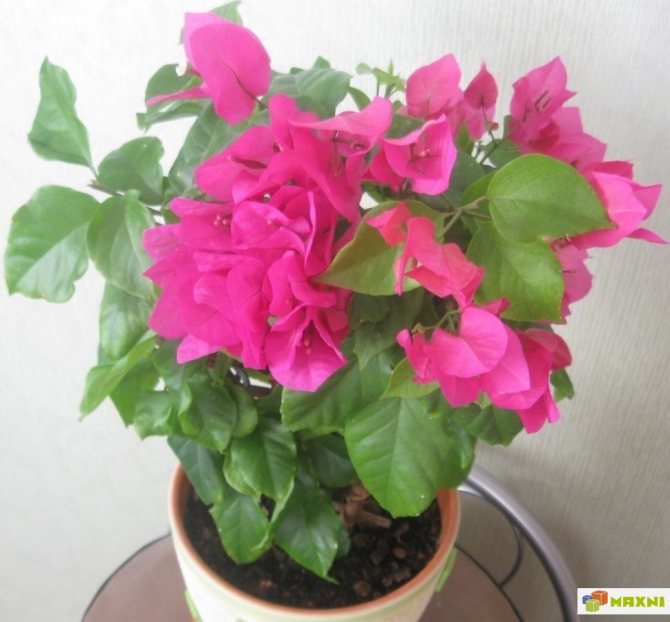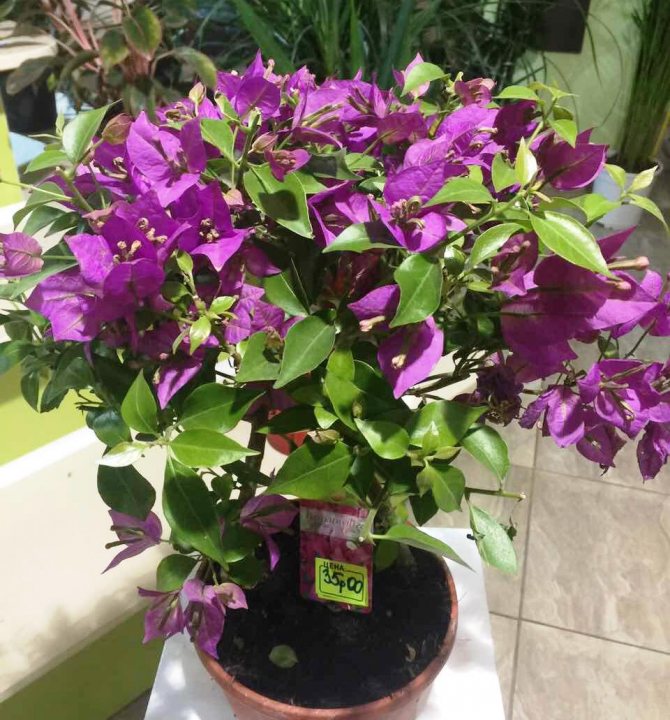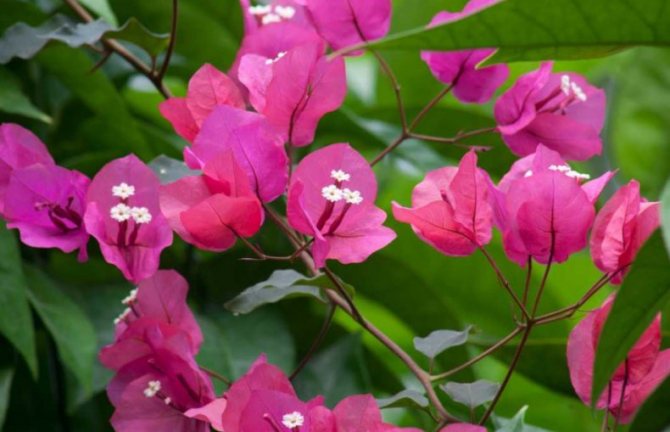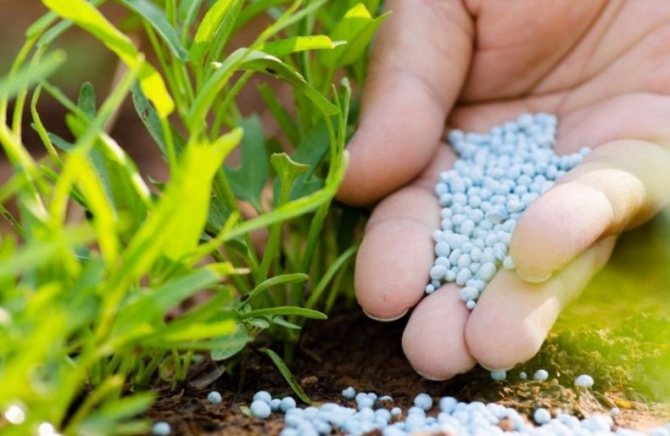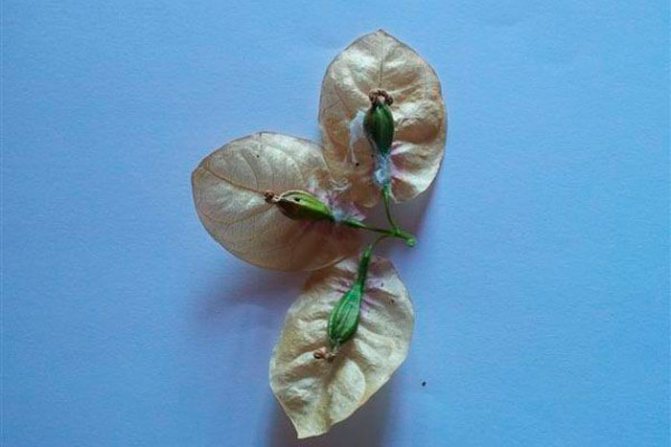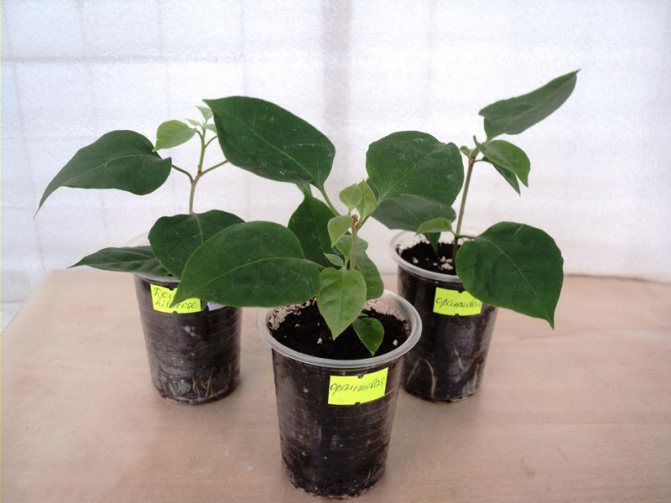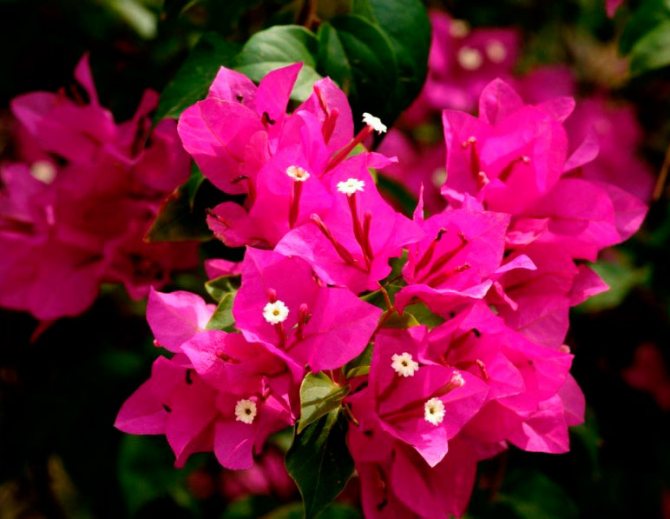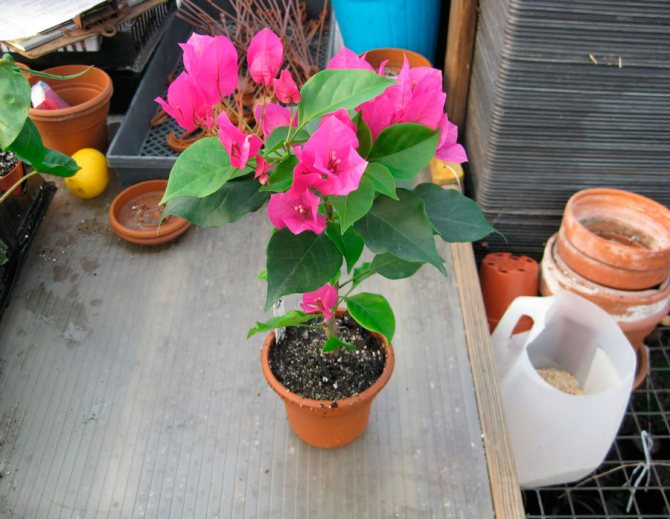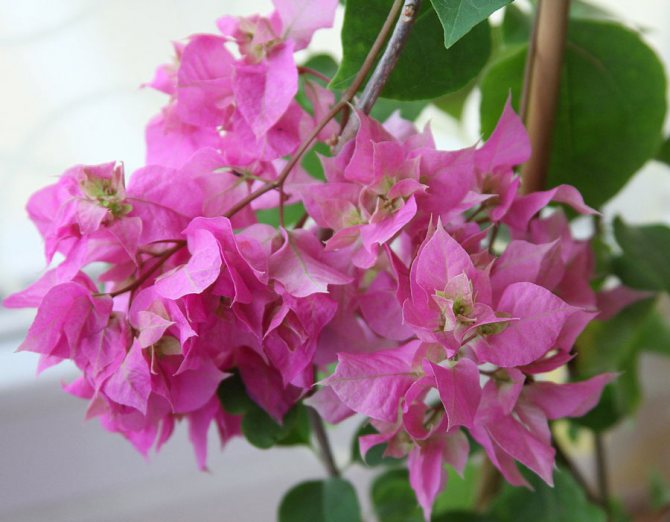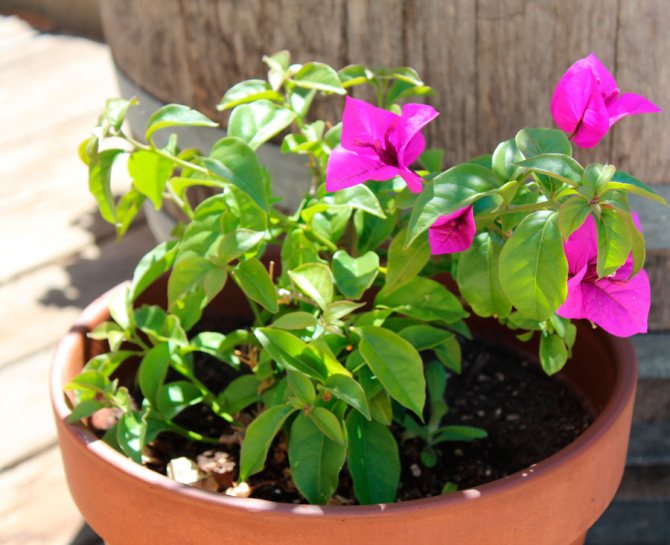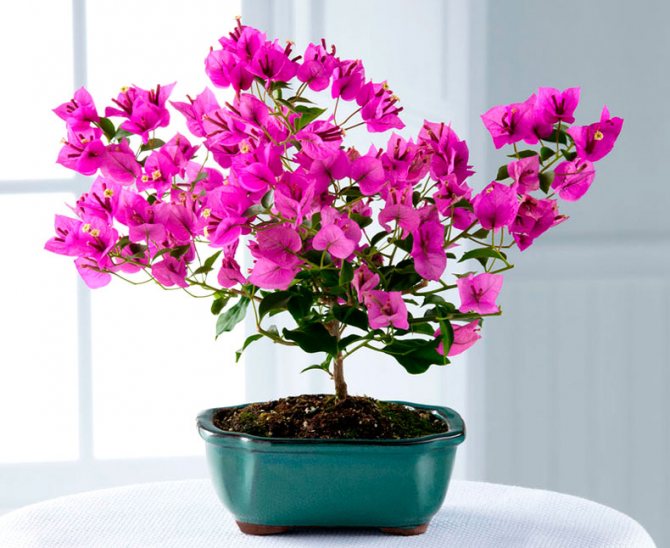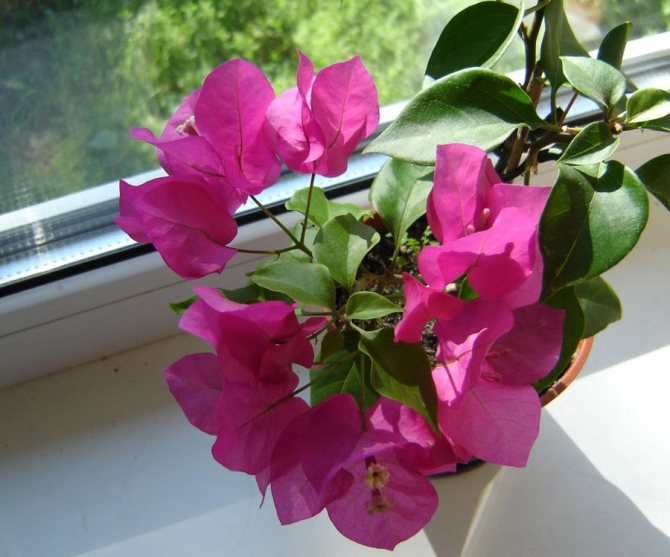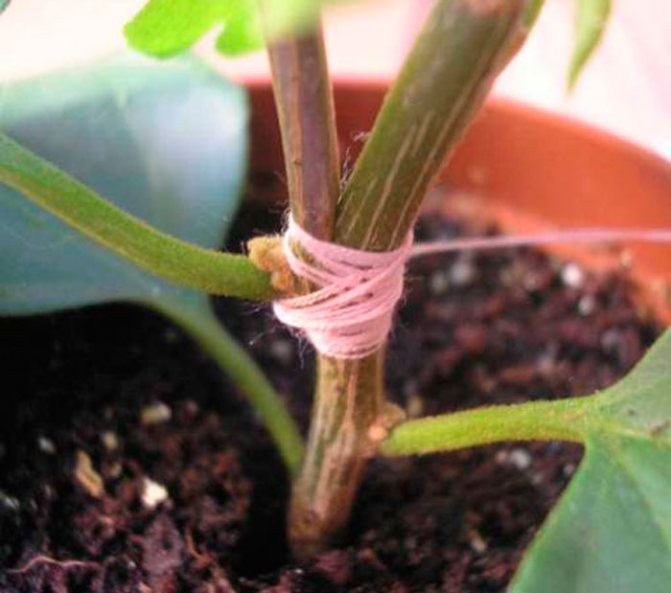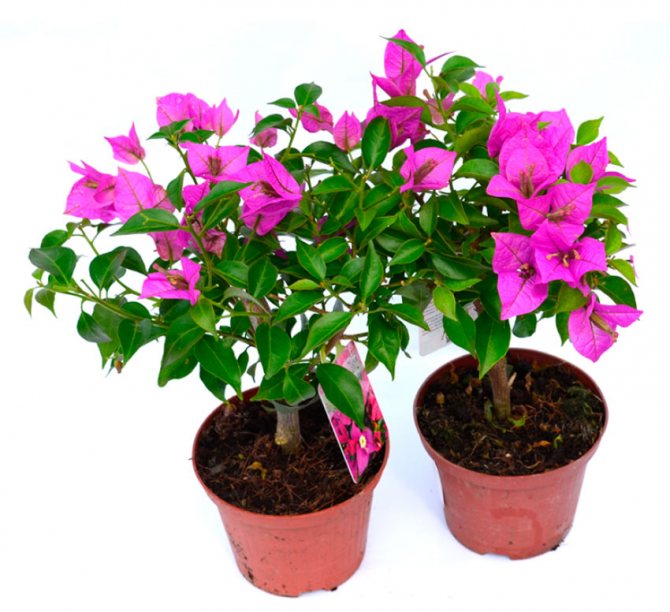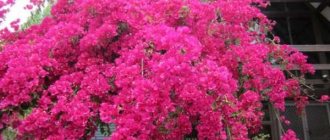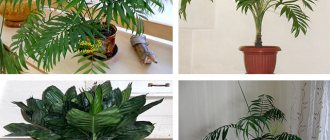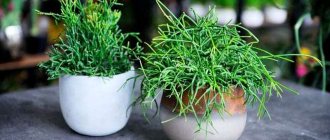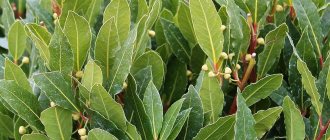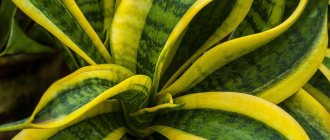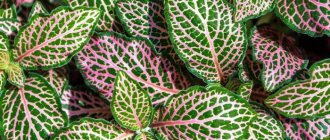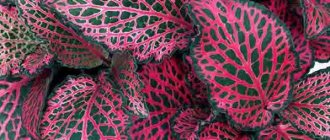Description of the flower
Bougainvillea is a perennial plant with long, creeping branches. The shrub is tall, with good care it can reach 5 meters in height. The branches of an adult flower over time begin to lignify and thicken, which gives the plant the appearance of a miniature tree. The trunk is covered with dark brown bark, which turns gray with age. Branches are spreading, covered with sharp long thorns.
Young shoots are covered with oval-shaped leaves of bright green color. The sheet has one peculiarity - it is folded along the central vein.
The shrub becomes covered with small single flowers during flowering. The plant gained its popularity not because of the flowers, but because of the large bracts that surround the nondescript flower. In shape, it looks like a leaf with a thin transparent surface. The color can be any: from snow-white to dark crimson. Bougainvillea flowers fade much earlier than the bracts.
Fruits are formed only with natural pollination. In natural conditions, butterflies and hummingbirds are pollinators. When grown in an apartment, the plant does not form fruit.
Types and varieties
The bougainvillea genus is small, it includes only 14 plant species. Popular varieties for growing on a personal plot and at home:
- Bougainvillea nude... The variety got its name due to the lack of thorns on the stem. During the flowering period, and in the southern regions it lasts up to 9 months, the plant produces small golden flowers surrounded by crimson bracts. They can grow both around the flower and around the entire inflorescence.
- Bougainvillea is beautiful... Long curving shoots are covered with dark velvety leaves. During the flowering period, the shrub is covered with a hat of numerous snow-white flowers.
- Bougainvillea Peruvian... The variety differs from others in that it does not release side shoots. The branches are covered with narrow long leaves with thorns at the base. The multi-flowered Peruvian bougainvillea has double stipules with a slightly wrinkled surface.
Home care
When growing a shrub in captivity, it requires constant care and attention. With good care, the flower will delight with long and beautiful flowering.
Basic rules of care:
- watering and feeding;
- pruning;
- transfer;
- preparation for winter;
- disease prevention.
Lighting and temperature control
To obtain a beautiful and healthy bougainvillea, the main thing is to surround the plant with care and love.
Since the plant is thermophilic, it is grown only on the south side in direct sunlight. The plant does not like to be periodically moved, otherwise it sheds all its foliage, exposing the spiked trunk.
The main role for long-term flowering is played by the temperature regime. During the growing season and flowering, it should be at least 20-25 degrees. In winter, the temperature is lowered to 10 degrees, placing the flower in a cool room. If the temperature drops to a minus mark, the shrub dies, when the air temperature rises, the flower wakes up and begins to grow green mass.
If the plant is not sent to hibernation, then it will continue to bloom throughout the winter, but the summer flowering from this plant will not wait.
Watering and feeding
For long-term flowering, the plant needs timely watering and feeding. Do not allow the soil to dry out during the flowering period. But overflow will also be the main reason for decay of the root system. Therefore, many gardeners carry out watering through the pallet. In winter, moisture evaporation is much slower, therefore, watering is reduced.
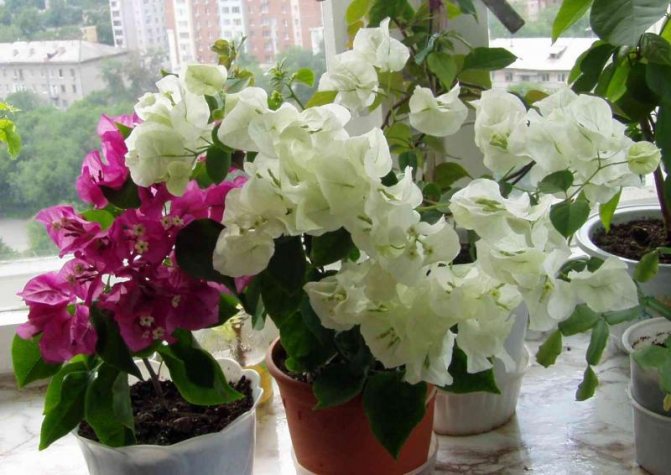
In the summer, the plant responds well to periodic double-sided spraying of the leaf plate. When spraying, it is necessary to ensure that drops of water do not settle on the bracts. Irrigation and spraying is carried out only with soft settled water. Tap water is not suitable for irrigation due to the high chlorine content.
A fast-growing plant also needs regular mineral fertilization. Fertilize it only during the period of active growth once a week. In winter, the shrub does not need feeding.
Soil composition and replanting
Bougainvillea is a fast growing plant and therefore needs to be repotted periodically. The size of the flower directly depends on the volume of the pot. The closer to the roots, the more abundant flowering and less growth. If a plant is planted in a large pot, it will devote all its strength to growing new young shoots, and it will have no strength and nutrients left for flowering.
Transplant rules:
- The shrub is transplanted only with an earthen clod.
- The soil should be nutritious with neutral acidity and consist of turf, leafy soil and sand in a ratio of 1: 1: 1.
- Expanded clay or brick chips, vermiculite and charcoal are added to the soil.
- Drainage is laid at the bottom of the pot with a layer of 2 cm.
The frequency of transplanting depends on the age of the flower. Young specimens need to be renewed annually, adults - as needed. After transplanting, the plant can finish flowering and discard all foliage, after a short time the plant will regain its foliage and its beauty.


Pruning and reproduction
Pruning is an important step in the care of your bougainvillea. It is carried out to form the crown, as well as for the prevention of diseases:
- Spring pruning - removes dried, thin, weakened shoots.
- Summer - removal of faded inflorescences.
- Autumn - crown formation.
During the spring pruning period, you can prepare cuttings for propagation. To do this, lignified shoots are cut by 13 cm. Prepared cuttings are treated in a solution of Kornevin or Epin for rapid root formation. Then they are buried in the nutrient soil and create a favorable microclimate using a micro greenhouse. The optimum temperature for rooting should be at least 25 degrees.
The microgreenhouse is periodically ventilated, and the soil is moistened with a spray bottle. Rooting occurs in 30 days. The first signs are the appearance of new young leaves.
Even an inexperienced florist can cope with a flower.
Bougainvillea disease
The resistance of a tropical plant to various pathologies is to be envied. Bougainvillea throws off leaves before winter rest? There is no need to worry about this natural process. If the process unpleasant for the grower occurred in another season, then the rules for caring for the shrub need to be revised.
According to certain signs, you can find out the reason for the "malaise" of an ornamental plant:
- Dropping the bracts. It is because of their beauty that bougainvillea is acquired. The reasons for the loss of bracts should be sought in moving to a new place, the end of the summer season and insufficient lighting.
- Disappearance of bright colors. The bracts become faded due to chlorosis. This disease occurs due to improper feeding, which does not include iron.
- The appearance of white spots on the leaves. They arise from insufficient ventilation or with an excessively moist substrate.Do not leave damaged leaves on the bush.
- Yellowing of the leaves. It will disappear if you stop feeding and spray the plant for a while. In the spring and summer, such an unpleasant phenomenon rarely occurs.
- Cessation of plant growth. It's time to change the cramped pot for a more spacious container. Old shrubs over 10 years old should be used as propagation material.
- The disappearance of the plant for an unknown reason. It is possible that its root system is rotting. Bougainvillea will disappear if the affected roots are not cut. It is recommended to keep the healthy part of them a little in phytosporin. Transplanting into a new substrate will help complete the treatment of the affected shrub.
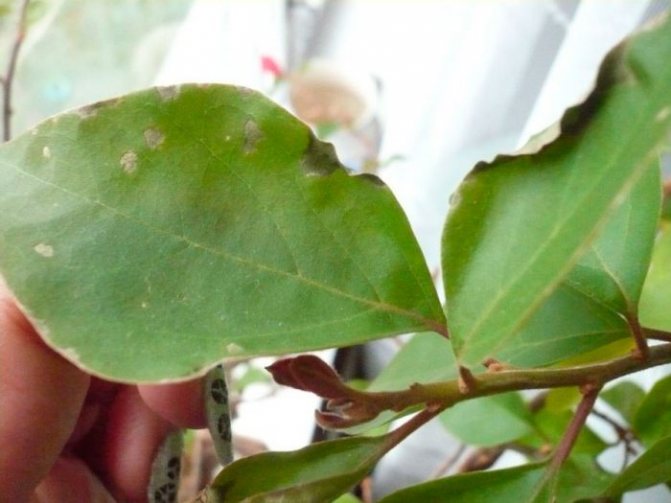

In the event that soft spots of white color have formed on the surface of the leaf plates, this indicates that stagnation of liquid is constantly observed in the soil mixture, and the room is poorly ventilated.
Bougainvillea pests
Bougainvillea is not a treat for all parasites, but their appearance is still likely. Unwanted guests may be:
- aphid;
- spider mite;
- mealybug;
- red tick;
- powdery mildew.
Unpleasant visitors are able to attack bougainvillea during the warm season. Bougainvillea can also suffer during winter dormancy if ticks take a liking to it.
In this case, you need to follow the instructions:
- Elimination of problem areas. The affected branches and leaves must be destroyed after cutting.
- Washing the plant. The entire bush should be rinsed with warm water, even with its entire zones.
- Treatment. After the bougainvillea dries, it is necessary to apply Fitoverm or Actellic on it, taking into account the three times daily treatment with them with a break of three days.
- With a serious lesion, sounded drugs cannot be dispensed with. "Karbofos" will come to the rescue when it comes to powdery mildew.
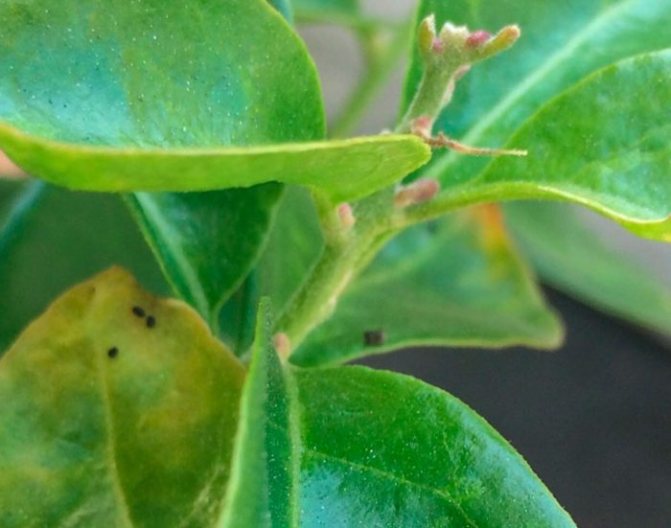

Sucking pests are extremely rare on bougainvillea.
Outdoor plant care
Since bougainvillea is a heat-loving shrub, it is grown outdoors only in the southern regions.
Warmth and light are the main factors for constant flowering. When the temperature drops to 0 degrees, the plant dies.
Watering in the summer is necessary abundant, it is gradually reduced by the fall and completely stopped in winter. After each watering, the soil is loosened and mulched. Mulch is essential to retain moisture and to nourish the root system.
Top dressing should be applied during the planting period; for this, organic matter is used and phosphorus-potassium fertilizers during the flowering period no more than 4 times a month.
Pruning garden bougainvillea is carried out in three steps:
- in spring - to stimulate intensive growth;
- in summer - crown formation;
- in the fall - shortening of young shoots and getting rid of old ones.
Landing rules
Bougainvillea can be planted in the garden, but then in the fall, during a cold snap, you will have to dig up the plant. Only in the south of the country does it winters with good shelter. It is much more convenient to immediately plant the flower in a pot, and move it to a large flowerpot as it grows. In the fall, he is brought into the room.
Young plants are transplanted annually, and for older specimens, one transplant is enough for 3-5 years. It is better to do this in the first half of spring. The root system develops slowly, so the next pot should be slightly larger than the previous one. You can leave the old container, but shake off some of the old earthen coma and slightly trim the roots.
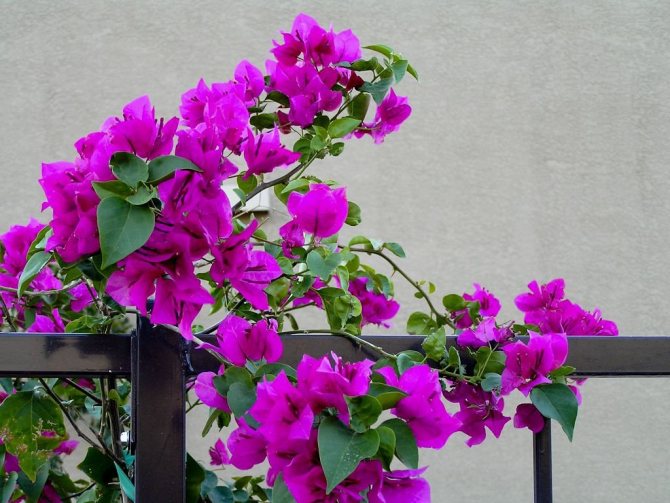

The optimal potting mix for planting bougainvillea should contain:
- sod land;
- deciduous humus;
- river sand;
- peat.
Drainage material must be poured at the bottom of the pot. When transplanting, the roots should be inspected for damage and trimmed. The earth is tamped and watered carefully.The first days of bougainvillea are kept in a shaded place.
Flower propagation
Garden bougainvillea can be propagated in several ways:
- Seeds... The seed method is the most difficult method of reproduction, and therefore it is better not to take it for a novice florist.
- Cuttings... For reproduction, cuttings from lignified shoots, cut in the summer, are used. Rooting takes place at a temperature of 25 degrees and high humidity. To create a microclimate, the plant is covered with a glass cover or plastic bag. The best rooting occurs when the container with the planting material is heated underneath.
- Layers... This breeding method can be carried out at any time of the year. To do this, choose young healthy shoots, tilt them to the ground and sprinkle them with nutritious soil. Cutting off at the point of contact with the ground must be injured in the form of a scratch or cut to stimulate root formation. When the shoot takes root, it is separated from the mother bush and transplanted to a permanent place.
Seat selection
To choose the right place for planting bougainvillea, you need to pay attention not only to the soil, but also to the degree of illumination of the site.
Lighting and shade
This plant is very fond of bright, diffused light, while it is not afraid of direct rays of the sun. In winter, bougainvillea has a dormant period, then the need for sun is slightly reduced. When growing a plant in a house, you should place it on the south side, otherwise you will need to provide additional lighting.
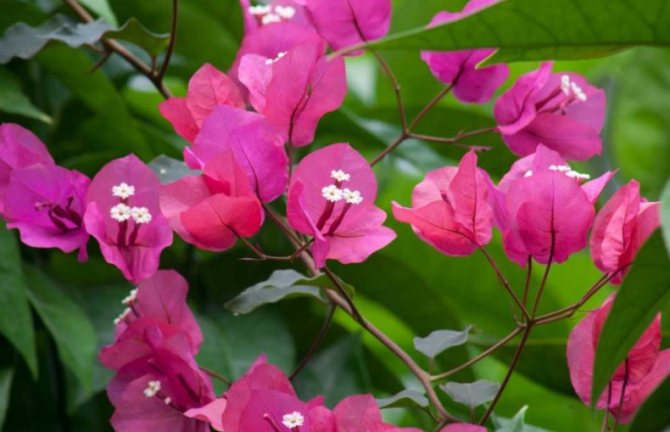

In order for bougainvillea to grow and bloom well, the temperature regime in summer must be maintained within 20-25 degrees, while in winter the decrease must be at least 12-16 degrees.
Growing soil
To grow bougainvillea bushes, you need a slightly alkaline dense soil. You can buy a ready-made substrate for tub plants in specialized stores, or prepare the mixture yourself. This will require three parts of leafy land, the same amount of sod land, two parts of peat and one part of fine-grained sand. The soil must allow air and water to pass through, so one should not forget about high-quality drainage.
Lack of flowering
If a florist notices that the plant sheds leaves and does not start flowering, first of all it is necessary to establish the cause and begin to correct the situation. Lack of flowering and loss of leaves can be triggered by the following factors:
- Frequent rearrangement and transplantation of the plant.
- Failure to comply with the temperature and humidity conditions.
- Insufficient lighting.
- Failure to provide the plant with a dormant period.
- Late pruning.
- Excess nitrogenous fertilizers in the soil.
You can grow shrubs both in your personal plot and in your apartment. Planting bougainvillea, growing and leaving is simple, and even a novice florist can handle them. Observing all the rules, you can grow a wonderful plant that will decorate any corner of the house or garden.
Preparing for winter
With the threat of night frosts, bougainvillea in a tub or container is transferred to a room, to diffused sunlight, at a temperature not higher than +16, for example, to a warm loggia. The branches that grew last summer are shortened by half.
Features of care during the rest period
Winter care consists in rare watering so that the roots do not dry out.
If you follow exactly useful tips, the capricious beauty will delight the owners for at least 10 years - this is how much the plant lives in garden conditions.


